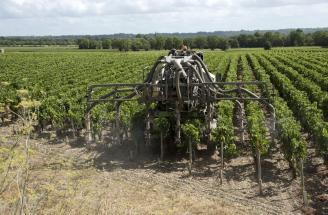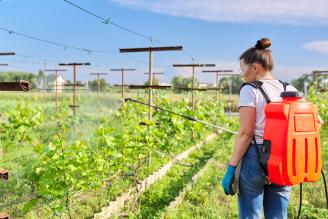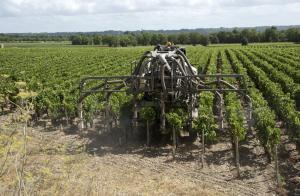How to limit aerial drift in viticulture?

The Écophyto II+ plan sets ambitious targets: to reduce the use of phytopharmaceutical products by 50% by 2025. For winegrowers, controlling aerial drift when spraying vines is a real challenge. How can drift be reduced without compromising vine protection? At SITEVI 2021, IFV and Inrae addressed this crucial issue. Here's a look back at the key points and developments since then.
Glossary |
The regulatory framework
As reducing aerial drift is a major issue for preserving the environment, crops and populations, a regulatory framework has gradually been established.
The decree of May 4, 2017 lays the foundations for the use of phytopharmaceutical products, in order to protect water points, vulnerable people and residential areas. In particular, this decree provides for:
- A ZNT (untreated zone) to be respected around water points, which is set when the product in question receives its marketing authorization (AMM).
- Safety distances when using products near residential areas, or areas where regular workers or vulnerable people are present.
These distances can be reduced by using equipment designed to reduce spray drift A list of such equipment is regularly updated.
How to measure spray drift?

There are three ways of expressing drift: sedimentary, aerial and exposure of local residents. Each must be measured using a specific method.
- Aerial drift: this is measured using droplet collectors, which can be placed on nylon wires or telescopic poles, at various distances from the treated area.
- Sediment drift: using Petri dishes at regular intervals, sediment drift can be measured after spraying.
- Exposure of local residents: four exposure pathways have been selected for measurement. These are drift during application, vapour emissions after application, contact with a contaminated surface and contact within treated crops.
The EoleDrift test bench
The EoleDrift project was set up to measure spray drift and better compare equipment performance. The aim is to identify the most efficient equipment, and then to promote methods of reducing spray drift.
Until now, the protocol for measuring drift in natural wind conditions has been far too cumbersome to apply. EoleDrift is a 5-meter-long, 5-meter-high wall that reproduces the wind. Used in conjunction with EvaSprayViti, an artificial vine, this test rig makes it possible to measure spray drift under "standard" wind and vine conditions.
Good to know |
Factors influencing aerial drift
Numerous factors can have an influence on drift during vineyard spraying. They concern environmental conditions, the methods applied and the characteristics of the vines themselves. Here are just a few of them:
- Wind speed and direction,
- Temperature and humidity,
- Air stability,
- Spray density,
- Product formula,
- Droplet size,
- Nozzle height,
- Spray pressure,
- Vineyard topography,
- Vine density,
- Row orientation,
- Spraying schedules.
Did you know? |
The TOPPS-Prowadis project
Launched in 2011 by ECPA (European Crop Protection Association), the TOPPS-Prowadis project proposes best practices to limit spray drift:
- Plan sprays according to weather forecasts (low wind, average temperatures, high humidity),
- Use nozzles that generate few fine droplets and favor low pressure,
- Use air-injection nozzles,
- Take into account the national classification of TRDP (Spray Drift Reduction Technologies),
- Make the right sprayer adjustments for each new application.
The new list of approved equipment
On April 25, the French Ministry of Agriculture published a new list of approved equipment for reducing spray drift and therefore ZNTs. 12 new viticulture sprayers have been added to the previous list dating from June 2022, with an efficiency coefficient to reduce drift of at least 66%.
The use of this equipment enables winegrowers to reduce the width of ZNTs around water points from 50 or 20 meters to 5 meters. The zones to be respected to protect local residents can also be reduced.
Going further: aerial drift in arboriculture
Arboriculture, like viticulture, must rise to the challenge of aerial drift. Several projects have been launched.
- PulvArbo project 2016-2020: led by CTIFL and piloted by the DGAL, the project aims to optimize spraying in fruit arboriculture. It focuses on 2 areas: firstly, identifying the most effective equipment, settings and practices, and secondly, adapting applied doses where possible.
- CAPRIV 2021-2022 project: starting in October 2020, the CAPRIV project focuses on the exposure of local residents to pesticides. It studies both technical solutions (settings, equipment, nozzles) and natural physical barriers such as hedges.
Limiting aerial drift during spraying is one of the agri-environmental measures needed to reduce the quantities of plant protection products used. To reduce environmental risks, the two main lines of action are to use more efficient equipment and, at the same time, to implement measures to reduce exposure to drift, by defining zones or planting hedges. The next SITEVI, scheduled for November 28-30 2023, should shed new light on the subject!
